|
|
 |

|
ORIENTAL LONGHAIR - JAVANESE
The Javanese - also called Oriental Longhair - is
a cat of oriental type, like his close relatives, the Balinese, the
Siamese and the Oriental Shorthair:
a very elegant, graceful and semi-longhaired cat. it is said that this breed
got its name after the dancers of Java.The Oriental Longhair cat is of medium size, her body is
slender and long, yet with a very well developed muscle strength, which is
quite hard and firm. The legs are high (long) and slender with fine oval
paws. The boning is fine and delicate.
The head builds a long wedge which tapers to a fine muzzle. The nose is
absolutely straight and long. The jaws are fine built. When viewing the head
in profile a long straight line can be seen, which starts at the top of the
head and continues straight to the tip of the nose. When viewing the head
from the front side the outer edges of the head build a long triangle.
The skull is not supposed to be flat, it is rounded, as if the cat would
wear a round helmet.
The neck is long, slender and graceful, thus emphasizing the elegant lines
of the Oriental Longhair cat.
The eyes are almond in shape and slanted to the base of the ears. Their
colour is of a striking green colour. This combination between the almond
shape and the oblique placement of the eyes emphasizes the oriental
appearance of this breed.
The ears are very large, very wide at their base, thus completing the
triangular shape of the head and continuing the outer lines of the head.
The coat is semi-long (not very long), very fine and shows almost no
undercoat. When you stroke the coat you get the feeling of pure silk.
Oriental Longhair cat are the solid coloured counterpart to Balinese, their
green eye colour makes this breed very attractive.
The tail is very long, rather thin and tapers to its tip. The coat on the
tail is not very bushy, rather flowing and forming a plume.
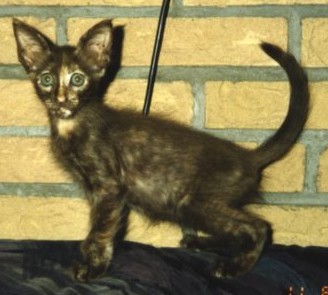
Izhayla's Cachora van Dahriënnha, chocolate tortie
Breeder
Annet Wouters
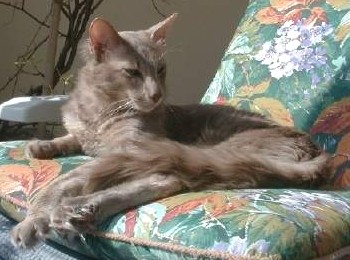
Vienna Blue Honey Dew, lilac spotted
Breeder
Christel Schirrer
|
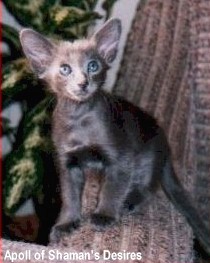
Apoll of Shaman's Desires, blue
Breeder
Carla Bracher
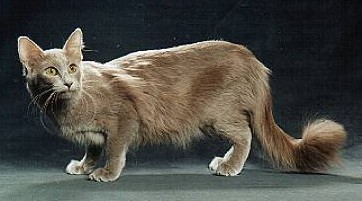
Xandra vom Gartenweg, lilac
Cattery the frizzled frolic
Owner Uschi Schwarzenbach
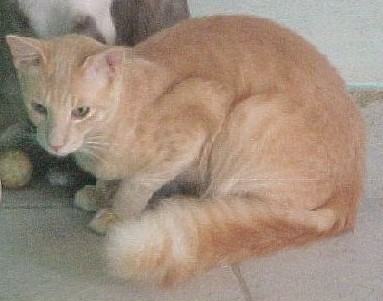
Da Capo von der Warfe, cream gspotted
Ishayla's cattery
Owner Annet Wouters |
Oriental Longhair exist in the same colours as Oriental
Shorthair:
- black, blue
- chocolate and lilac
- red and cream
- cinnamon and fawn
- tortie, i.e. with tortie patches (patches are red in black, chocolate
and cinnamon cats, and patches are cream in blue, lilac and fawn cats), all colours as mentioned above
- and all these colours exist also with tabby pattern - blotched,
mackerel, spotted and ticked, f.e. blue mackerel, black ticked, red
blotched, etc.
- all these colours exist also with silver as Smoke or as silver tabby,
f.e. black smoke, chocolate smoke, tortie smoke, red silver spotted, blue
silver ticked, bluetortie silver mackerel, etc.
- all these colours can be also with white, f.e. black and white, red
and white, blue blotched with white, etc.
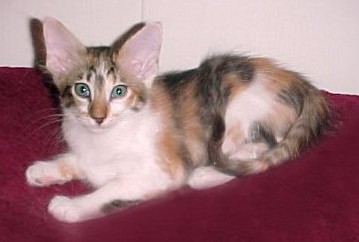
CH. Izhayla's Rishona Seliyi sê Iriana, tortie mackerel bicolour
Breeder
Annet Wouters
|
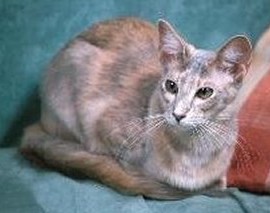
Int.CH. Faridah Khai Muk, bluetortie ticked
Izhayla's cattery
Owner Annet Wouters
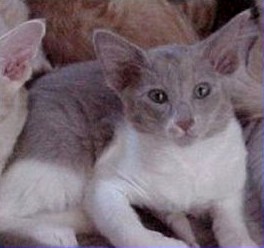
Izhayla's Oralee sê Keola
Restiemoor, lilac bicolour
Breeder Annet
Wouters
|
| History
Oriental Longhair cats exist as long as Balinese or Oriental Shorthair do
exist, because many of the original Siamese lines carried the rezessive gene
for longhair. Probably that gene for longhair traces its origin back to
crossings between Siamese and Turkish Angora or longhaired cats of oriental
body type. In England also outcrosses from Oriental Shorthair to Turkish
Angora had been made, because Turkish Angora shall have an oriental body
type. The names for this breed are confusing between the various cat
organisations. In CFA all Colourpoints, except the 4 basic colours (seal,
blue, chocolate and lilac) are called Javanese, and are recognized since
1986 in CFA, the solid coloured cats are called Oriental Longhair in CFA and
are recognized since 1995, thus representing a rather young breed. Solid
coloured Oriental Longhair cats are recognized in other federations already
for a long time. In GCCF in England those solid coloured Oriental Longhair
cats had been called Angoras up to now (do not mix them up with the Turkish
Angora, which is a separate breed), and will be renamed to Oriental Longhair
with June 2003. In FIFe those solid coloured Oriental Longhair cats had been
called Javanese up to now. In some other federations they are called
Mandarins.
|
| Temperament
Oriental Longhairs are talkative cats, they can get quite loud sometimes. Females,
which are in heat, and lonely studs can cry with an ear splitting voice.
But, in general they are more quiet and not so loud as Siamese. The
Oriental Longhair loves to communicate with her owner. They are active cats, who like
to play. If they feel lonely without any playmate, they create one, and
anything will be dedicated to become their playmate. Oriental Longhairs like to jump
quite high, but they keep their balance between the narrowest things with
great elegance, thus disrupting or disturbing very seldom something.
Oriental Longhairs are no outdoor cats, they like a cosy warm place. They like to sleep on top of
radiators, the television or the computer, or anything which creates heat.
They love their owners and demand attention and affection, they enjoy
riding on their shoulders or cuddling on their knees, or to cuddle in bed
under a warm blanket.
These extremely intelligent cats make very good companions for people, who
like to have constant companionship. Oriental Longhairs will follow you, wherever you
go, if you sit down, they will sit on your lap, if you eat, they will sit
besides you on the chair, without being demanding or begging for food, if go
to bed, they will enjoy to sleep in your bed with you. With Oriental
Longhairs you will have a very attractive companion and they will be your
friends for a life time.
|
| Grooming
Oriental Longhairs require rather little grooming, because of their thin
coat. Brushing their coat and combing it gentle will remove dead hears and
will produce a lovely silk-like glistening coat. |
|
|
|
|
|
|
|
|
|
|  |

|
|
Service is our success
|
Member of

|
|
|
|
|
|
|
